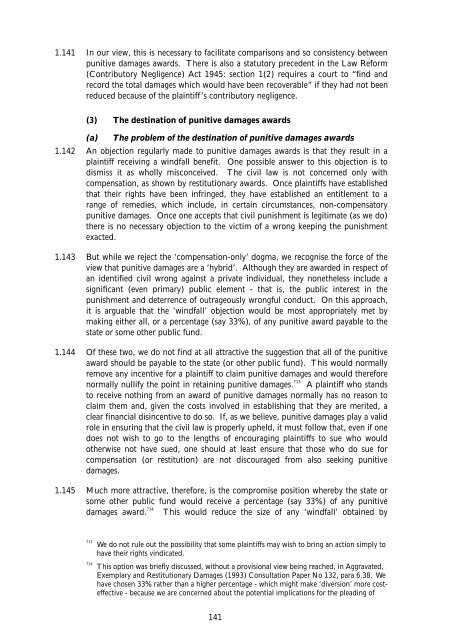Aggravated, Exemplary and Restitutionary ... - Law Commission
Aggravated, Exemplary and Restitutionary ... - Law Commission
Aggravated, Exemplary and Restitutionary ... - Law Commission
Create successful ePaper yourself
Turn your PDF publications into a flip-book with our unique Google optimized e-Paper software.
1.141 In our view, this is necessary to facilitate comparisons <strong>and</strong> so consistency between<br />
punitive damages awards. There is also a statutory precedent in the <strong>Law</strong> Reform<br />
(Contributory Negligence) Act 1945: section 1(2) requires a court to “find <strong>and</strong><br />
record the total damages which would have been recoverable” if they had not been<br />
reduced because of the plaintiff’s contributory negligence.<br />
(3) The destination of punitive damages awards<br />
(a) The problem of the destination of punitive damages awards<br />
1.142 An objection regularly made to punitive damages awards is that they result in a<br />
plaintiff receiving a windfall benefit. One possible answer to this objection is to<br />
dismiss it as wholly misconceived. The civil law is not concerned only with<br />
compensation, as shown by restitutionary awards. Once plaintiffs have established<br />
that their rights have been infringed, they have established an entitlement to a<br />
range of remedies, which include, in certain circumstances, non-compensatory<br />
punitive damages. Once one accepts that civil punishment is legitimate (as we do)<br />
there is no necessary objection to the victim of a wrong keeping the punishment<br />
exacted.<br />
1.143 But while we reject the ‘compensation-only’ dogma, we recognise the force of the<br />
view that punitive damages are a ‘hybrid’. Although they are awarded in respect of<br />
an identified civil wrong against a private individual, they nonetheless include a<br />
significant (even primary) public element - that is, the public interest in the<br />
punishment <strong>and</strong> deterrence of outrageously wrongful conduct. On this approach,<br />
it is arguable that the ‘windfall’ objection would be most appropriately met by<br />
making either all, or a percentage (say 33%), of any punitive award payable to the<br />
state or some other public fund.<br />
1.144 Of these two, we do not find at all attractive the suggestion that all of the punitive<br />
award should be payable to the state (or other public fund). This would normally<br />
remove any incentive for a plaintiff to claim punitive damages <strong>and</strong> would therefore<br />
normally nullify the point in retaining punitive damages. 713<br />
A plaintiff who st<strong>and</strong>s<br />
to receive nothing from an award of punitive damages normally has no reason to<br />
claim them <strong>and</strong>, given the costs involved in establishing that they are merited, a<br />
clear financial disincentive to do so. If, as we believe, punitive damages play a valid<br />
role in ensuring that the civil law is properly upheld, it must follow that, even if one<br />
does not wish to go to the lengths of encouraging plaintiffs to sue who would<br />
otherwise not have sued, one should at least ensure that those who do sue for<br />
compensation (or restitution) are not discouraged from also seeking punitive<br />
damages.<br />
1.145 Much more attractive, therefore, is the compromise position whereby the state or<br />
some other public fund would receive a percentage (say 33%) of any punitive<br />
damages award. 714<br />
This would reduce the size of any ‘windfall’ obtained by<br />
713 We do not rule out the possibility that some plaintiffs may wish to bring an action simply to<br />
have their rights vindicated.<br />
714 This option was briefly discussed, without a provisional view being reached, in <strong>Aggravated</strong>,<br />
<strong>Exemplary</strong> <strong>and</strong> <strong>Restitutionary</strong> Damages (1993) Consultation Paper No 132, para 6.38. We<br />
have chosen 33% rather than a higher percentage - which might make ‘diversion’ more costeffective<br />
- because we are concerned about the potential implications for the pleading of<br />
141
















